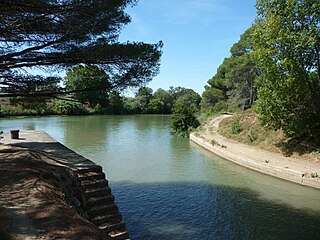Canal de Jonction (Aude)
| Canal de Jonction | |
|---|---|
|
The Canal de Jonction near Sallèles-d'Aude |
|
| Water code | FR : undefined |
| location | France , Occitania region |
| length | 5 km |
| Built | 1787 |
| class | I ( Freycinet class ) |
| Beginning | Branch from the Canal du Midi near Port la Robine |
| The End | Confluence with the Aude south-east of Sallèles-d'Aude |
| Descent structures | 7th |
| Kilometrage | Direction to the river Aude |
| It flows into the Aude river, then further downstream (to the left) to the beginning of the Canal de la Robine | |
The approximately 5 km long Canal de Jonction (German: connecting canal ), also Canal de Narbonne , is a shipping canal in the Aude department of the administrative region of Occitania in southern France . It is entirely in the municipality of Sallèles-d'Aude . The Canal de la Robine was connected to the Canal du Midi via it .
Course and technical infrastructure
The Canal de Jonction branches off from the Canal du Midi near its canal bridge over the river Cesse and flows after about 5 kilometers and about 21 meters lower into the river Aude about 1 kilometer southeast of the center of Sallèles-d'Aude. The descent takes place through seven locks , the water of which comes from the Canal du Midi.
The connection to the Canal de la Robine is not direct, but is about 650 meters downstream on the opposite (right) bank of the Aude above a weir. This enables river navigation from the confluence of the Canal de Jonction. The Canal de la Robine, which begins here at Moussoulens ( Moussan municipality ), first leads to Narbonne and then on to Port-la-Nouvelle and into the Mediterranean .
Coordinates
- Starting point of the canal: 43 ° 17 ′ 0 ″ N , 2 ° 55 ′ 20 ″ E
- End point of canal: 43 ° 14 ′ 45 ″ N , 2 ° 57 ′ 21 ″ E
history
When the Canal du Midi was built, no connection to the Canal de la Robine was planned for the time being, although only a distance of five kilometers had to be overcome. It was only 100 years later that the Archbishop of Narbonne, Monseigneur Dillon, succeeded in convincing the Riquet family of the importance of this project. In 1787 the Canal de Jonction was then dug, connecting the Canal de la Robine, on which Narbonne lies, with the Canal du Midi, which was then in its economic heyday.
Economical meaning
The cargo shipping has gradually lost importance. Today the canal is mainly used by pleasure boats and houseboats . Water tourism along the Canal du Midi is of great importance.
Web links
literature
- Voies Navigables, Canaux du Midi , 1998, Editions Grafocarte Verlag ISBN 2-7416-0054-6

